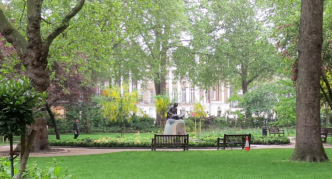 View across Tavistock Square, Gandhi statue in the centre.
View across Tavistock Square, Gandhi statue in the centre.
 View across Tavistock Square, Gandhi statue in the centre.
View across Tavistock Square, Gandhi statue in the centre.
Tavistock Square, Bloomsbury, twinned with Gordon Square, was started by James Burton in the 1800s, and completed by Thomas Cubitt in the 1820s, both working as builders for the Duke of Bedford’s estate. The original terraced houses are still in place on the West side, rather dark brick, rather plain, with a central range with attached Ionic pillars and pilasters, and mostly owned by the University of London. Among various literary and other associations, Charles Dickens lived there in the 1850s, and in the 20th Century, Virginia Woolf and the Hogarth Press were in the Square. In the open gardens within the Square are three works of 20th Century sculpture.
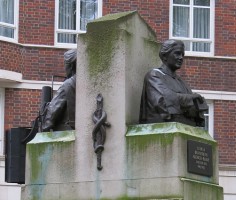 Louisa Aldrich-Blake, by A. G. Walker.
Louisa Aldrich-Blake, by A. G. Walker.
The earlier work is the double bust of Louisa Aldrich-Blake, 1926, in bronze, at one corner of the Square so that one bust faces inwards, one outwards from the gardens. The work is by the sculptor A. G. Walker, interesting for his ideal figures, but also a notable portrait sculptor, whose work in London includes, among others, the Florence Nightingale in Waterloo Place. The elegant stone structure supporting the sculpture is by the architect Edwin Lutyens. The staff and coiled snake on the side indicates her medical career.
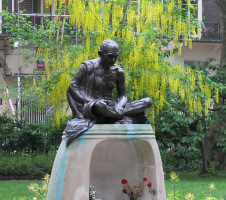 Gandhi statue, by Fredda Brilliant.
Gandhi statue, by Fredda Brilliant.
Leaping forward 40-odd years, the centrepiece of the gardens is a statue of Gandhi, seated cross-legged, and when surrounded with yellow Laburnum and reddish copper beech, looks rather mystical. An example of how a not particularly large statue can give focus to a sizeable open garden. It is interesting to see an example of public figure sculpture from the 1960s: Gandhi is portrayed as elderly, thin, head bowed, wearing but a thin robe so that much of his body, an arm, and lower legs are exposed. The artist has emphasised the wrinkles of the face, the veins of the hands, the slackness of the wasted muscles over the bones – it is indeed a rather anatomical sculpture. Fredda Brilliant was the sculptor. She was of Polish origin, and lived for periods in Australia, the US and Russia before settling in England in the 1930s, and in the 50s and 60s living in India, where she made statues of various Indian politicians.
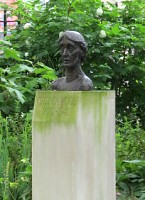 Bust of Virginia Woolf, by Stephen Tomlin.
Bust of Virginia Woolf, by Stephen Tomlin.
Another bust stands in a corner of the gardens, which is of Virginia Woolf, a modern copy of a 1930s work by Stephen Tomlin, also one of the Bloomsbury Group. Made in a modernistic style, it looks undersized as mounted on the large stone block; some moulding at the top might have given some sense of proportion.
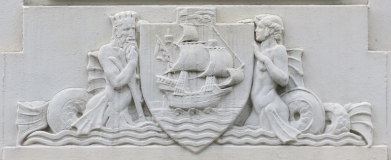
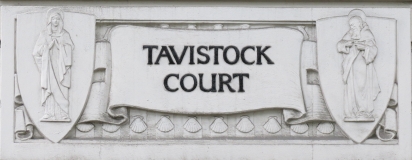
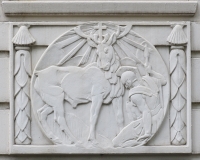 Art deco panels on Tavistock Court.
Art deco panels on Tavistock Court.
We have one more sculptural work to see, rather unexpectedly on one of the more modern buildings fronting onto the Square, a building called Tavistock Court situated on the North West side of the Square by Endsleigh Street. Here are several panels in white marble. A mermaid and merman hold up a shield with a ship on it; in a second panel are an identical pair, but with a different ship. A second design is of a Classical warrior kneeling before a large stag, with behind the animal’s head, a crucifix emitting rays of light; again the composition is repeated, this time identical but in reverse. A final plaque bearing the name ‘Tavistock Court’, has two shields with a praying female, very nicely done, and an old monk or saint. Modest, but very typical art deco work, and the anonymous sculptor is skillful.
South to Bloomsbury Square // West to Gordon Square // East to St George's Gardens
Visits to this page from 13 Mar 2014: 9,647